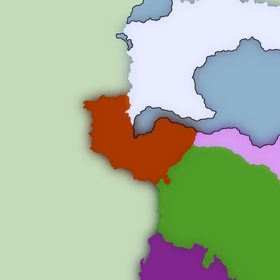Gwaxol
| Gwaxol | |
|---|---|
| gwaxol⁵ | |
 xazat³ gwaxolsa⁵ in the Hanoehn script | |
| Pronunciation | [gʷɑ˩xo˥ɮ̊] |
| Created by | Dillon Hartwig |
| Date | 2022 |
| Setting | Pollasena |
| Native to | N/A |
| Era | -800 to 200 MT |
| Official status | |
Official language in | N/A |
Range Map of Gwaxol (brown), alongside Khelaj (white), 'Oa (pink), Ku Te Kui (green), and Thuosha' (purple), c. -600 MT | |
Gwaxol /ˈgwɑhoʊl/ (Gwaxol: gwaxol⁵ [gʷɑ˩xo˥ɮ̊]) is a mixed Wasc-Nentammmi language spoken in the southeastern Thotthashnem Desert.
Etymology
Gwaxol⁵, the language's autonym, is inherited from the Wascotl autonym *wasc-otl.
Orthography
Gwaxol is written with the Hanoehn script. Its romanization is as follows.
- Hyphens disambiguate /Cʷ, θ, ŋ, z̃/ ⟨Cw, th, ng, nz⟩ from /Cɣʷ, th, ng, nz/ ⟨C'w, t'h, n'g, n'z⟩
- Tone numbers are written word-finally
Phonology
Consonants
| Labial | Dental | Alveolar | Palatal | Velar | Labialized velar | Glottal | ||||
|---|---|---|---|---|---|---|---|---|---|---|
| Nasal stop | m | n | ŋ | ŋʷ | ||||||
| Nasal fricative | z̃ | |||||||||
| Stop | t | d | k | g | kʷ | gʷ | ||||
| Fricative | θ | s | z | ʝ | x | ɣ | xʷ | ɣʷ | h | |
| Lateral | ɬ | ɮ | ||||||||
| Trill | r | |||||||||
- /ŋ, z̃, θ/ only occur in loanwords.
- All consonants can be geminated intervocalically
- All consonants assimilate in voicing to following consonants and all voiced consonants devoice word-finally, but this voicing change does not come with fortition/lenition; for example /ɮ/ devoices to [ɮ̊] rather than [ɬ], and /ɬ/ voices to [ɬ̬] rather than [ɮ].
Vowels
| Front | Central | Back | ||
|---|---|---|---|---|
| High | i | ɨ | ʉ | u |
| Close-mid | e | ɵ | o | |
| Mid | ə | |||
| Open-mid | ɛ | |||
| Low | ɑ | |||
- /ɛ/ only occurs in loanwords.
Tones
Gwaxol has six word tones.
| High | Low | High falling | Low falling | Rising | Dipping |
|---|---|---|---|---|---|
| ˥-˥ | ˩-˩ | ˥-˧ | ˧-˩ | ˩-˥ | ˥-˩-˧ |
- /˩-˩, ˧-˩/ only occur in loanwords.
Tones are realized with pitch shifting throughout the word from the first tone to the second; in words with dipping tone, pitch is lowest at the end of the penultimate syllable and rises in the final syllable.
| High | Low | High falling | Low falling | Rising | Dipping | |
|---|---|---|---|---|---|---|
| Monosyllable | hën¹ "it is it" /ən˥˥/ [hə˥n̥] |
gey² "it counts it" /geʝ˩˩/ [ge˩ʝ̊] |
zis³ "it gives it" /zis˥˧/ [zi˥˧s] |
dëy⁴ "it laughs at it" /dəʝ˧˩/ [də˧˩ʝ̊] |
hëgw⁵ "it finds it" /əgʷ˩˥/ [hə˩˥g̊ʷ] |
thöt⁶ "it savors it" /θɵt˥˩˧/ [θɵ˥˩˧t] |
| Disyllable | sekën¹ "I am it" /sekən˥˥/ [se˥kə˥n̥] |
sekgey² "I count it" /sekgeʝ˩˩/ [se˩k̬ge˩ʝ̊] |
sekzis³ "I give it" /sekzis˥˧/ [se˥k̬zi˧s] |
sekdëy⁴ "I laugh at it" /sekdəʝ˧˩/ [se˧k̬də˩ʝ̊] |
sekëgw⁵ "I find it" /sekəgʷ˩˥/ [se˩kə˥g̊ʷ] |
sekthöt⁶ "I savor it" /sekθɵt˥˩˧/ [se˥˩kθɵ˧t] |
| Trisyllable | sekëni¹ "I was it" /sekəni˥˥/ [se˥kə˥ni˥] |
sekgeyi² "I counted it" /sekgeʝi˩˩/ [se˩k̬ge˩ʝi˩] |
sekzisi³ "I gave it" /sekzisi˥˧/ [se˥k̬zi˦si˧] |
sekdëyi⁴ "I laughed at it" /sekdəʝi˧˩/ [se˧k̬də˨ʝi˩] |
sekëgwi⁵ "I found it" /sekəgʷi˩˥/ [se˩kə˧gʷi˥] |
sekthöti⁶ "I savored it" /sekθɵti˥˩˧/ [se˥kθɵ˩ti˧] |
| Quadrisyllable | sekënilen¹ "I was not it" /sekəniɮen˥˥/ [se˥kə˥ni˥ɮe˥n̥] |
sekgeyilen² "I did not count it" /sekgeʝiɮen˩˩/ [se˩k̬ge˩ʝi˩ɮe˩n̥] |
sekzisilen³ "I did not give it" /sekzisiɮen˥˧/ [se˥k̬zi˦si˦ɮe˧n̥] |
sekdëyilen⁴ "I did not laugh at it" /sekdəʝiɮen˧˩/ [se˧k̬də˨ʝi˨ɮe˩n̥] |
sekëgwilen⁵ "I did not find it" /sekəgʷiɮen˩˥/ [se˩kə˨gʷi˦ɮe˥n̥] |
sekthötilen⁶ "I did not savor it" /sekθɵtiɮen˥˩˧/ [se˥kθɵ˧ti˩ɮe˧n̥] |
- For some speakers non-monosyllable /˥-˥/ and /˩-˩/ are realized as weakly rising [V˦...V˥] and [V˩...V˨].
Atonal words bear the last tone in the preceding word, but word-initially either bear the first tone in the following word or have variable pitch.
Prosody
Stress
Stress is root-initial and is realized with increased volume and/or vowel length, the latter especially in contrastive stress.
Intonation
Emphasized words have more volume across the word and length in the word's stressed vowel. Emphasized atonal words in isolation have sharply falling pitch.
In semantically imperative and hortative sentences pitch starts higher than in declarative sentences.
In nonpolar questions and expressions of surprise or doubt pitch is lower before the most emphasized word and sharply rises after the word.
Phonotactics
Syllables are underlyingly (C)V(C). Obstruents except /z̃, θ, ʝ/ cannot occur before consonants of different voicing except on morpheme boundaries.
Epenthetic [h] is added before vowels word-initially and between vowels on morpheme boundaries.
Morphology
Alignment
Gwaxol has tripartite morphosyntactic alignment, but in informal speech may be ergative-absolutive.
Pronouns
Pronouns are marked for case, class, and number.
In familial and very informal speech, these possessive pronouns are also used as ergative and intransitive pronouns.
|
|
| ||||||||||||||||||||||||||||||||||||||||||||||||||||||||||||||||||||||||||||||||||||||||||||||||||||||||||||
When converbial suffixes are unused, subject referent switching is marked with the pronoun kang². Kang² is unused in non-subject referent switching.
Only personal and possessive pronouns cause agreement in verbs; if a non-personal/possessive is a core argument, the other argument causes intransitive agreement, and if there is no personal or possessive pronoun to cause agreement the verb is marked as impersonal.
Negative pronouns must be applied to negative verbs.
Nouns
Nouns are marked for class, case, number, and definiteness. Proper nouns are not marked for class.
All core arguments of hën¹ are marked as intransitive. PossessionPossessed nouns are marked with a preceding possessive pronoun agreeing in class. Possessor-possessum pairs are each marked with the same case. Predicative possession is marked with hën¹ and dative possessum. VerbsVerbs agree with both agent and patient in class, and mark tense, aspect, and mood.
|
||||||||||||||||||||||||||||||||||||||||||||||||||||||||||||||||||||||||||||||||||||||||||||||||||||||||||||||||||||||||||||||||||||||||||||||||||||||||||||||||||||||||||||||||||||||||||||||||||||||||||||||||||||||||||||||||||||||||||||||||||||||||||||||||||||||||||||||||||||||||||||||||||||||||||||||||||||
